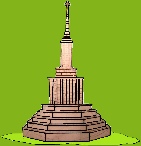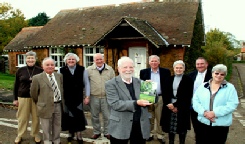
 Local Business, Food, Accommodation
History Group
Local Events
Local Business, Food, Accommodation
History Group
Local Events




 Summary of Castle Rising
Summary of Castle Rising
















John de Sandale, Castle Rising’s earliest known rector. 1270(?)-
Ann has recently discovered a document entitled “The registers of John de Sandale and Rigaud de Asserio – Bishops of Winchester (AD 1316-
John was born in Yorkshire near Doncaster, in the manor of either Wheatley or Sandale. The Manor of Wheatley belonged to him in 1301 when he obtained a grant from King Edward I for the right of free warren in all the demesne lands at Wheatley. In 2nd April 1311 he obtained a licence to crenellate his dwelling house there and enclose it with a stone wall. He also owned the Manor of Great Coates in Lincolnshire, South of the Humber. This shows that he was from the upper echelons of society. Around 1294, he became a member of the King’s Court as a Clerk in the King’s Wardrobe. It seems likely that he would start this position when he was still a teenager, but this is speculative, since we don’t know exactly when he was born. He must soon have received a Knighthood, because in 1300 he was paid as Sir John de Sandale for a 25 day trip between London and Caerlaverock [in Galloway].
From evidence below he was nominated as Rector of Castle Rising between 1295 and 1297. He was the immediate predecessor of John de Cockermuthe (or Cockermouth) who was the first rector recorded in the “Institution Book of the Registry of the Lord’s Bishop of Norwich” in which the records began in 1299. Cockermuthe was Rector of Castle Rising from 1302 until 1309. Baigent documented that John de Sandale was Cockermuthe’s immediate predecessor and he must have been nominated before 1299, when Registry records began. He was presented according to Baigent by Roger de Montalt, who was Lord of the Manor of Castle Rising only from 1295 to 1297, so this limits the possible dates of his inauguration. He was therefore Rector of Castle Rising for between 5 and 7 years. Whenever he was nominated, he must have been a young man. It was his first religious appointment. He was appointed by Sir Roger de Montalt, who was clearly close to the King’s Court.
De Sandale had therefore both a secular and a religious role in society, and this appears to have been common at the time. He travelled extensively to Gascony, where he appears to have been transferring money for the payment of troops. In 1305 he was promoted to the office of Chamberlain of Scotland and also Keeper of the King’s Caravan (responsible for arrangements when the King travelled the country). His career prospered and may even have been enhanced in 1307 when Edward I died and Edward II came to the throne. In that year on 20 Aug., he was appointed Chancellor of the Exchequer by King Edward II. On the 26th September 1314 he was elected to the highest secular position in the land, that of the King’s Treasurer. He was said to be one of the King’s favourites, a term reminiscent of Piers Gaveston and Hugh Despenser, the younger.
In addition to his secular career, de Sandale also had a religious one. Even when he was rector of Castle Rising, he also had the parish of Wimbish in Essex. He continued to acquire parishes, which usually were associated with some financial benefit. He was presented with parishes in England, Scotland and Ireland usually at the instigation of King Edward II. The King himself wrote a letter to the Pope in which he strongly commended Sir John de Sandale to the pontiff. The Bishopric of Winchester, one of the foremost in the Kingdom became vacant on 28th June 1316 and the King ensured that de Sandale would be nominated for that position. He was duly elected on 22 September 1316, to one of the highest positions in the Church.
John de Sandale perhaps found two such important and difficult roles (Bishop of Winchester and King’s Treasurer) too much for him and he died on 2 November 1319. In his short spell as Bishop he had travelled extensively but there is no evidence that he visited his former church at Castle Rising. One of the most interesting pieces of information to appear in Baigent’s account was the fact that the two executors of Sir John de Sandale’s Will were John de Cockermuthe and John de Heydene. It is surely no coincidence that these two men were both Rectors of Castle Rising following John de Sandale: John de Cockermuthe(from 1302 to 1309) immediately after de Sandale and John de Heydene (from 1309 to 1318).Cockermuthe is recorded by Baigent as having been de Sandale’s successor at Castle Rising, but John de Heydene is reported (in 1319) as the Rector of Alresford in Hampshire. However in 1319 he was no longer Rector of Castle Rising, so there is no contradiction. It seems almost certain that these three men had all been Rectors of Castle Rising, the latter two having been presented by Roger de Montalt, son of Robert
If John de Cockermuthe and John de Heydene are indeed both Executors of de Sandale’s Will and Rectors of Castle Rising, then we can speculate a little about them. It is likely that they came from a similar social status and they were likely part of the de Montalt’s entourage. It further suggests that the de Montalts were particularly influential in Royal circles in the late thirteenth and early fourteenth century. If as with de Sandale, their names indicate their place of origin, then de Cockermuthe probably came from Cockermouth in Cumberland and de Heydene from the village of Heydon near to Reepham in Norfolk.